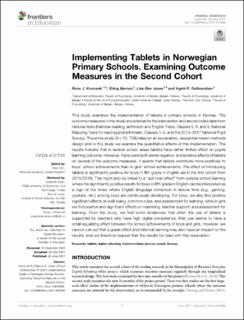| dc.description.abstract | This study examines the implementation of tablets in primary schools in Norway. The outcome measures in the study are external for the intervention and are recorded data from national tests (National reading, arithmetic and English Tests, Classes 5, 8, and 9, National Mapping Tests for reading and arithmetic, Classes 1–3, and the 2014–2017 National Pupil Survey). The entire study (N = 15, 708) relies on an explanatory, sequential mixed-methods design and in this study we examine the quantitative effects of this implementation. The results indicate that in several school areas tablets have rather limited effect on pupils learning outcome. However, there were both some negative- and positive effects of tablets on several of the outcome measures. It seems that tablets contribute more positively to boys’ school achievements than to girls’ school achievements. The effect of introducing tablets is significantly positive for boys in fifth grade in English (as in the first cohort from 2015/2016). This might also be linked to a “spill over-effect” from outside school learning where the significantly positive results for boys in fifth grade in English can be interpreted as a sign of the times where English language immersion in leisure time (e.g., gaming, youtube, etc.) among boys are continuously developing. For boys, we also find positive significant effects on well-being, common rules, and assessment for learning, while in girls we find positive and significant effects on mastering, teacher support, and assessment for learning. From the study, we find some tendencies that when the use of tablets is supported by teachers who have high digital competence, their use seems to have a small equalizing effect between the school achievements of boys and girls. However, we cannot rule out that a grade effect and informal learning may also have an impact on the results, and we therefore request that the results be read with this reservation. | en_US |

